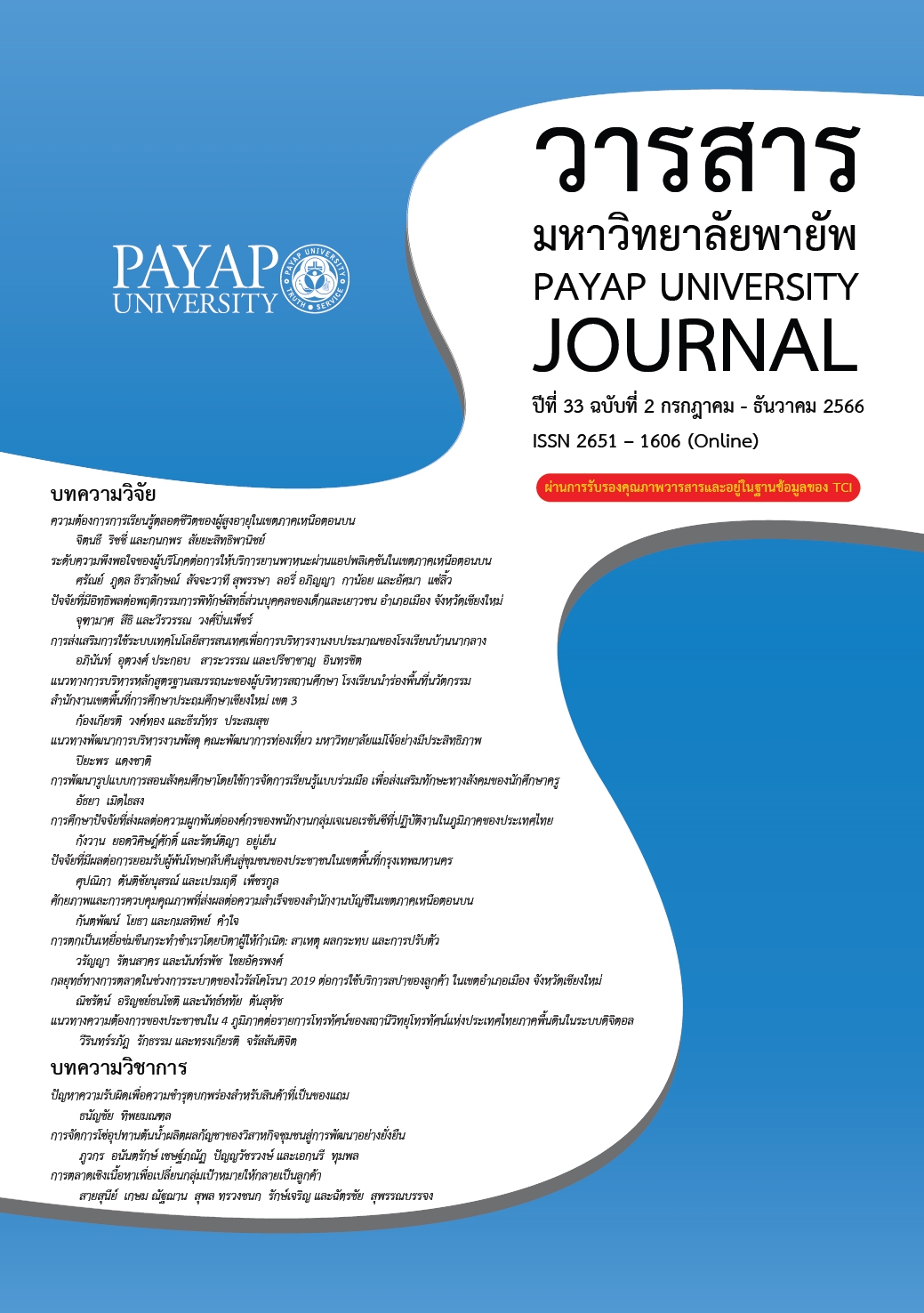ปัจจัยที่มีอิทธิพลต่อพฤติกรรมการพิทักษ์สิทธิ์ส่วนบุคคลของเด็กและเยาวชน อำเภอเมือง จังหวัดเชียงใหม่
Main Article Content
บทคัดย่อ
การวิจัยครั้งนี้ มีวัตถุประสงค์เพื่อศึกษาปัจจัยที่มีอิทธิพลต่อพฤติกรรมการพิทักษ์สิทธิ์ส่วนบุคคลของเด็กและเยาวชน อำเภอเมือง จังหวัดเชียงใหม่ กลุ่มตัวอย่างในการศึกษาวิจัยครั้งนี้ คือ เด็กและเยาวชนอายุ 13 - 18 ปี ที่กำลังศึกษาในระดับชั้นมัธยมศึกษาในอำเภอเมือง จังหวัดเชียงใหม่ จำนวน 442 คน คัดเลือกกลุ่มตัวอย่างด้วยวิธีการสุ่มแบบหลายขั้นตอน เครื่องมือ การวิจัย ได้แก่ แบบสอบถาม การวิเคราะห์ข้อมูลใช้การวิเคราะห์โมเดลมิมิค
ผลการวิจัย พบว่า แบบจำลองมีความสอดคล้องกับข้อมูลเชิงประจักษ์ โดยเส้นอิทธิพลมีนัยสำคัญทางสถิติที่ .05 ทุกตัวแปร และพบว่าตัวแปรสาเหตุที่ศึกษา ได้แก่ การสนับสนุนทางสังคมและการเห็นคุณค่าในตนเองสามารถร่วมกันอธิบายความแปรปรวนของพฤติกรรมการพิทักษ์สิทธิ์ส่วนบุคคลได้ร้อยละ 47 นอกจากนี้ยังพบว่า การสนับสนุนทางสังคมเป็นปัจจัยเชิงสาเหตุที่มีอิทธิพลรวมสูงสุดต่อพฤติกรรมการพิทักษ์สิทธิ์ส่วนบุคคล โดยมีขนาดอิทธิพลรวม เท่ากับ .66 ขณะที่การเห็นคุณค่าในตนเอง พบว่า มีขนาดอิทธิพลรวม เท่ากับ .10 ดังนั้น ถ้าต้องการให้เด็กและเยาวชน อำเภอเมือง จังหวัดเชียงใหม่มีพฤติกรรมการพิทักษ์สิทธิ์ส่วนบุคคลที่เหมาะสม สามารถปกป้องสิทธิ์ของตนเอง และแสดงออกอย่างเหมาะสม ควรได้รับการสนับสนุนทางสังคมจากพ่อแม่ ครู ผู้ปกครอง โรงเรียนและเพื่อน และส่งเสริมให้เด็กและเยาวชนเห็นคุณค่าในตนเอง
Article Details
เอกสารอ้างอิง
กรมกิจการเด็กและเยาวชน. (2562). สถิติข้อมูลและสถานการณ์ด้านเด็กและเยาวชน ประจำปี 2562. http://dcy.go.th/webnew/upload/download/file_th_20201705214233_1.pdf
กรมกิจการสตรีและสถาบันครอบครัว (2562). รายงานข้อมูลสถานการณ์ด้านความรุนแรงในครอบครัว สำหรับการรายงานตามาตรา 17 แห่งพระราชบัญญัติคุ้มครองผู้ถูกกระทำด้วยความรุนแรงในครอบครัว พ.ศ.2550 ประจำปี 2561. ผู้แต่ง.https://dl.parliament.go.th/ handle/lirt/562792
จิรังกูร ณัฐรังสี. (2563). ก้าวข้ามความรุนแรงสู่การใช้วินัยเชิงบวกในการแนะแนวทางเด็กและเยาวชน. เวชสารแพทย์ทหารบก, 73(3), 173-179.
เฉลิมพล สวัสดิ์พงษ์, วิชัย วงษ์ใหญ่, ศิริยุภา พูลสุวรรณ, และมนัส บุญประกอบ. (2551). การพัฒนาหลักสูตรกลุ่มสาระการเรียนรู้ภาษาต่างประเทศ เพื่อสร้างเสริมการเห็นคุณค่าในตนเองของนักเรียน ระดับชั้นมัธยมศึกษาปีที่ 2. วารสารศึกษาศาสตร์ มหาวิทยาลัยขอนแก่น, 31(3), 31-40.
บ้านพักเด็กและครอบครัวจังหวัดเชียงใหม่. (2564). สรุปผลการดำเนินงานประจำปีงบประมาณ 2564. ผู้แต่ง.
สุฑาทิพย์ คำเที่ยง. (2562, 3 มกราคม). ความรุนแรงในเด็กและเยาวชน: ตั้งใจ หรือ แค่พลั้งเผลอ. ศูนย์สมเด็จพระเทพรัตนฯ โรงพยาบาลจุฬาลงกรณ์ สภากาชาดไทย. https://craniofacial.or.th/ aggressiveness-in-youth.php
Adams, C. D. (2015). Development of the self-advocacy measure for youth: Initial validation study with caregivers of elementary students with attention-deficit/hyperactivity disorder [Graduate Theses and Dissertations, University of South Florida]. Digital Commons @ University of South Florida. https://scholarcommons.usf.edu/etd/5445
Briggs, D. A. (2014). Perspectives of a peer-mentoring program on self-esteem, self-advocacy, and leadership skills [Doctor of Education, Walden University]. ProQuest Dissertations and Theses Global.
Coopersmith, S. (1984). SEI: Self-esteem inventories. Consulting Psychologist Press.
Diamantopoulos, A., & Siguaw, J. A. (2000). Introducing LISREL. SAGE.
Dowrick, P. W., Anderson, J., Heyer, K., & Acosta, J. (2005). Postsecondary education across the USA: Experiences of adults with disabilities. Journal of Vocational Rehabilitation, 22(1), 41-47.
Eriks-Brophy, A., Durieux-Smith, A., Olds, J., Fitzpatrick, E., Duquette, C., & Whittingham, J. (2006). Facilitators and barriers to the inclusion of orally educated children and youth with hearing loss in schools: Promoting partnerships to support inclusion. Volta Review, 106(1), 53–88.
Goodley, D. (2005). Empowerment, self-advocacy and resilience. Journal of Intellectual Disabilities, 9(4), 333–343. https://doi.org/10.1177/1744629505059267
Johnson, J. I. M. (2015). The relationship between social support and self-advocacy in college students with disabilities [Doctoral dissertation, University of Denver]. https://digitalcommons.du.edu/etd/1040/
Mirels, H. L., & McPeek, R. W. (1977). Self-advocacy and self-esteem. Journal of Consulting and Clinical Psychology, 45(6), 1132–1138. https://doi.org/10.1037/0022-006X.45.6.1132
Michael, R., & Zidan, H. M. (2018). Differences in self-advocacy among hard of hearing and typical hearing students. Research in Developmental Disabilities, 72, 118–127.
Norusis, M. J. (1995). SPSS 6.1: Guide to data analysis. Prentice Hall.
Schaefer, C., Coyne, J. C., & Lazarus, R. S. (1981). The health-related functions of social support. Journal of Behavioral Medicine, 4(4), 381-406. DOI: 10.1007/BF00846149.
Steven, J. (1996). Applied multivariate statistics for the social sciences (3rd ed.). Lawrance Erlbaum.
Williams, P., & Shoultz, B. (1982). We can speak for ourselves: Self-advocacy by mentally handicapped people. Souvenir Press.
Wongpakaran, T., & Wongpakaran, N. (2012, January 25). A Comparison of reliability and construct validity between the original and revised versions of the Rosenberg self-esteem scale. Psychiatry Investigation, 9(1), 54-58. DOI: https://doi.org/10.4306/pi.2012.9.1.54
Yamane, T. (1967). Statistics, an introductory analysis (2nd ed.). Harper and Row.
Zegar, M., & Baumann, A. (2012, July 9). Fostering self-advocacy in elementary-aged students with hearing loss. Audiologyonline. http://www.audiologyonline.com/articles/fosteringselfadvocacy-in-elementary-6583


